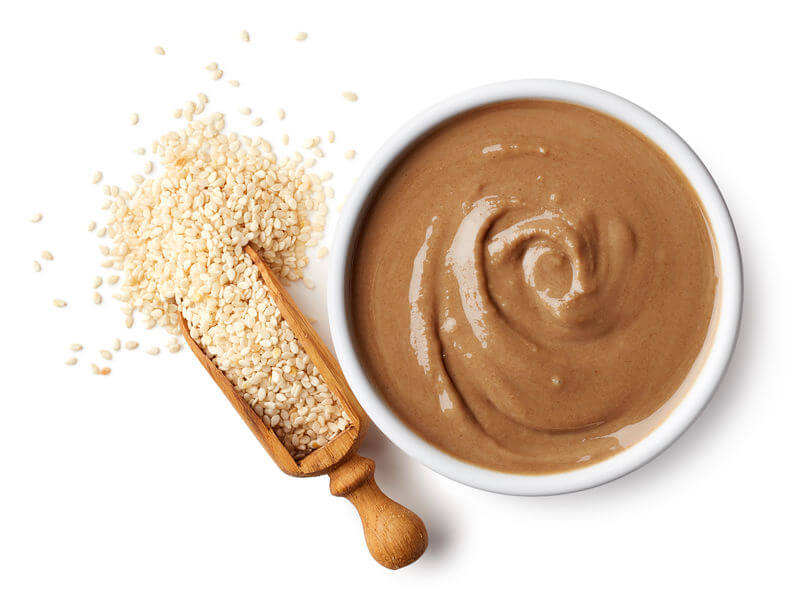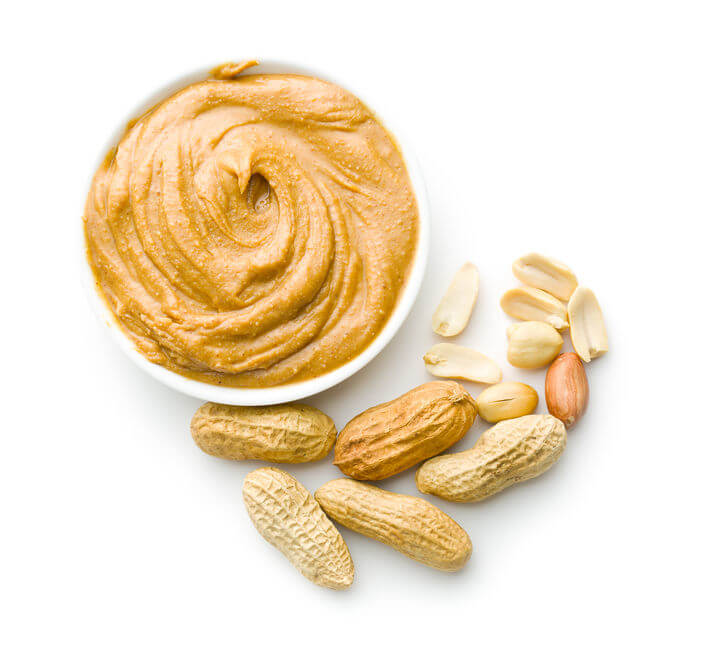When it comes to creamy spreads, foodies have no shortage of options to explore. There are ample nut butters (and nut-free recipes) available to sample these days. You might think they’re all more or less the same, but the truth is that they’re made from a wide range of base ingredients, featuring different tastes, nutrients, and preferred uses. When it comes to tahini vs peanut butter though, it helps to understand exactly what’s included in each product and what benefits you stand to gain by selecting one or the other.
In truth, tahini and peanut butter are nutritionally similar, in terms of calories per serving, as well as protein, fat, and other daily values. However, they are made from very different ingredients.
Here’s what you need to know before choosing tahini vs peanut butter.
What is Tahini?

You may have seen and sampled tahini-based sauces at your favorite Mediterranean and Middle Eastern restaurants. If you tried them, you probably noticed a familiar flavor.
Tahini is a creamy butter or paste made from hulled sesame seeds (the same pale ones you sprinkle on salads and teriyaki chicken) that have been roasted and ground, often with the addition of oil to create a smooth, creamy texture.
While it can be made from darker, unhulled seeds, the resulting paste will have a grainier texture and a slightly bitter taste.
What is Peanut Butter?

Most Americans are familiar with peanut butter, a kitchen staple used to make the PB&Js most had for lunch daily throughout elementary school.
Perhaps the most popular nut butter, peanut butter isn’t actually made with nuts. Despite having the word “nut” right in the name, peanuts are legumes.
Much like tahini, the process of making peanut butter involves shelling, roasting, and grinding the nuts with oil to create a creamy spread.
Nutritional Value of Tahini VS Peanut Butter
Now that you know what separates these two spreads, it’s time to see how they stack up nutritionally.
You might be surprised to find out that they are fairly similar, despite the fact that one is made from sesame seeds and the other is crafted from peanuts.
A 2-tablespoon serving of tahini contains the following:
- Calories: 178
- Fat: 16g
- Carbs: 6g
- Fiber: 3g
- Sugar: Less than 1g
- Protein: 5g
- Sodium: 34mg
How does peanut butter measure up? A 2-tablespoon service of Jif Creamy Peanut Butter includes the following:
- Calories: 190
- Fat: 16g
- Carbs: 8g
- Fiber: 2g
- Sugar: 3g (including 2g added sugars)
- Protein: 7g
- Sodium: 140mg
Carbs, Sugar & Salt
As you can see, tahini and peanut butter are close on almost every score, although peanut butter has a bit more carbs and sugars and significantly more sodium.
Fat Content
You’ll probably note that each has a pretty high fat content, but in each case, this is largely unsaturated fat.
Tahini has just 2g of saturated fat per serving, while Jif has 3.5g.
Minerals & Electrolytes
A single serving of tahini delivers 22% of your recommended daily value of phosphorus, as well as 14% iron, 12% calcium, and 8% magnesium.
Peanut butter offers 30% niacin, 10% Vitamin E, and 4% each of iron and potassium.
Health Benefits of Tahini VS Peanut Butter
One of the best reasons to use hulled sesame seeds for tahini — aside from more desirable flavor and texture — is that the hulls prevent the body from absorbing some of the many nutrients these seeds provide.
Antioxidants
Sesame seeds have more phytosterols than other seeds and nuts, providing benefits like lower cholesterol while potentially reducing risk factors for certain cancers.
They also contain antioxidants called lignans that can support immune health and hormonal balance.
These antioxidants may help with osteoarthritis pain, too, according to studies.
Healthy Fats
Although peanuts are high in fat, they also have a fair amount of protein, which helps with satiety and may contribute to weight management.
Healthy fats in peanut butter could reduce risk factors related to heart disease as well, while the combination of protein and healthy fats can be a great addition to bodybuilding diets when used in moderation.
Potential Allergies
Both peanut butter and sesame seeds come with risk of allergy. Peanuts have long numbered among the most common food allergies, along with tree nuts like almonds, cashews, and walnuts — although, again, peanuts are legumes.
Sesame allergies have received more recent recognition, but are still not required to be declared on labels under U.S. federal law. If you have tree nut allergies, you may be more likely to have a sesame seed allergy, as well.
Making Your Own Spreads
If you don’t like the additives in store-bought spreads, you might want to try your hand at making them from scratch.
When it comes to making your own, for tahini vs peanut butter, you’ll find the process to be fairly comparable between the two.
Homemade Tahini
Tahini is relatively affordable and easy to find in the grocery store, but if you’re trying to control your diet, you might want to make your own at home.
You may find this option to be slightly more expensive, but it’s incredibly easy, provided you have a food processor on hand.
You can either buy toasted sesame seeds or toast them yourself to bring out the natural flavors.
Simply place the seeds in a dry, shallow pan and toast over medium heat, stirring or swirling until they turn golden brown (about three minutes). They burn easily, so keep a close eye on them!
Next, put cooled, toasted sesame seeds into the food processor and process until a paste starts to form. Add an oil of your choice, one tablespoon at a time, until your desired consistency/creaminess is reached.
Some prefer a thick paste, while others like tahini a bit runnier. You can also sprinkle in a little sea salt to taste, if you like.
Homemade Peanut Butter
Making your own peanut butter is similar, except you don’t really need to add oil, as these legumes have enough of their own. You can either buy plain or roasted peanuts and process them until thick and creamy, with a sprinkle of sea salt to taste.
To oven roast shelled peanuts before processing, place them in a single layer on a dry baking sheet and bake for 15-20 minutes at 350°, shaking or stirring every 5 minutes to avoid scorching.
Difference In Taste Between Tahini and Peanut Butter
Both peanuts and sesame seeds have a rich, nutty flavor, especially when they’ve been toasted. Both are mild in flavor. Sesame seeds have a slightly sweet edge.
Although they can be used in many of the same recipes, you’ll find that the flavor is different, which may help you to decide which option to use for different dishes.
Uses For Tahini and Peanut Butter
Both tahini and peanut butter work great as a spread or dip for:
- Toast
- Crackers
- Veggies
- Fruits
Both can be used in baked goods to add nutty appeal or mixed into dressings, smoothies, oatmeal, and more for extra richness.
Peanut butter is a nice enhancement for cookie recipes, as it brings a savory, nutty complexity to sweets.
Because sesame seeds are slightly sweeter to begin with, tahini makes a wonderful addition to already savory sauces like hummus and baba ghanoush.
Which Option is Right for You?
The tahini vs peanut butter debate is a tough one to settle, as these two spreads are similar in many ways. The deciding factor is likely to rest on your personal flavor preference, unless you happen to be allergic to one or the other.
What you’re sure to find is that both can be used in a number of ways to add variety to your diet.

